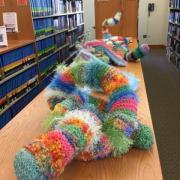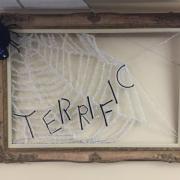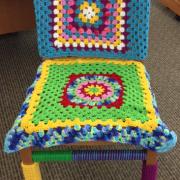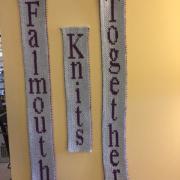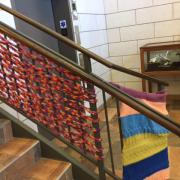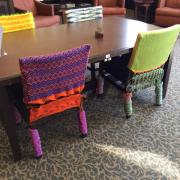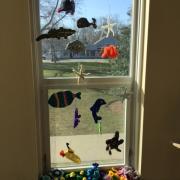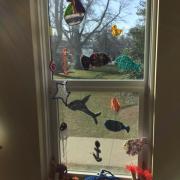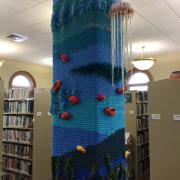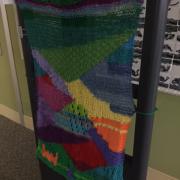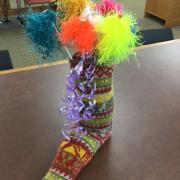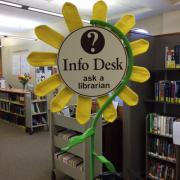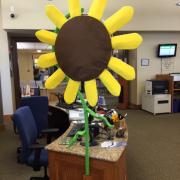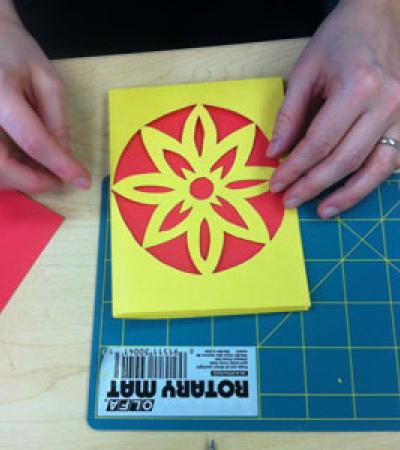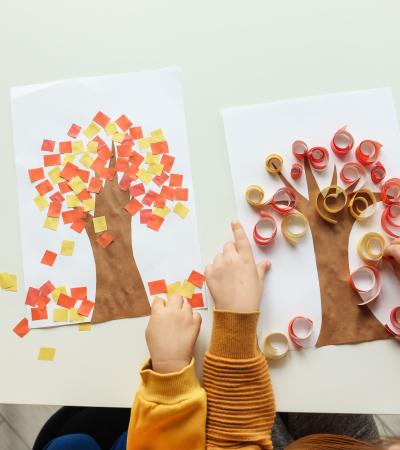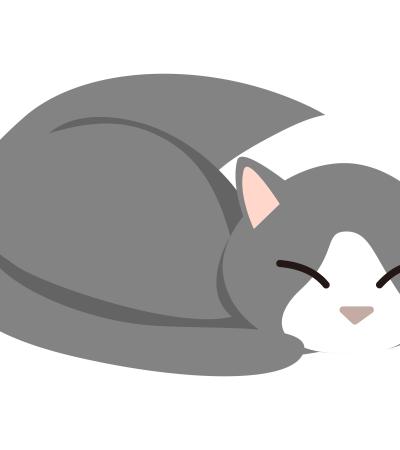Library Yarns was an eight-week mission in which people came together to knit, crochet, wrap, weave, braid and whatever else they could think of doing with yarn to embellish the Falmouth Public Library. During the first seven meetings we worked on our projects together. The final meeting was devoted to installing our creations for a colorful and whimsical one-month display, after which we hosted an opening reception for the public.
Marketing
We had two stages of marketing for the program. Stage 1 entailed soliciting yarn donations for one month. I created posters and wrapped donated cardboard boxes with colorful paper and placed them in five locations around town. The posters stated that the yarn would be used for a program in the coming months to "embellish the library." Only the box in the main library yielded any donations — about 50 pounds of yarn. Surprisingly, the boxes at the local yarn and coffee shops where people knit regularly remained empty. (View posters and other marketing materials under Attachments at right.)
In Stage 2, we advertised the meetings. I sent a press release to three local papers; hung posters in the library and around town; posted to about five online calendars; posted on Facebook, Twitter and our blog; and sent PSAs to our local NPR radio station and community TV station. Our two local yarn shops helped spread the word, too. The response wasn't as great as I had hoped because people were unclear on the concept of decorating the library with yarn creations. Thirteen people signed up initially, but as we went along people dropped in for a few meetings and some had to leave the program early.
Budgeting
The only essential costs were for hooks to hang the creations — under $15. Some materials we had on hand, such as yarn crafting books, Internet access to view ideas online, tape, scissors, paper, pencils, plastic bags, coffee-making supplies, and a tablecloth and centerpiece for reception table.
Some materials were donated or loaned: cardboard boxes for collecting yarn, wrapping paper to cover boxes, yarn, measuring tapes, rug anti-slip strips for tacking knitting onto chairs, painter’s tape for hanging knit pieces, coffee and cream for meetings.
Crafters supplied their own tools: needles, hooks, stitch markers, etc. The group offered to bring in homemade refreshments for the reception, but I was able to charge it to our Friends refreshment fund. Optional costs for refreshments and paper goods came to about $135 (to serve 100).
Day-of-event Activity
Leading up to the reception, we had several meetings. For the first meeting, we set up tables and chairs in center of room for working; tables at the edges for displaying books; supplies and coffee; and a large video screen and computer. I presented the plan, showed images from online and in our books of "yarn bombing," then gave a tour of the library. We brainstormed ideas, selected yarns and got to work.
For meeting 2 through 7, we worked, shared ideas and finished projects, which I collected. At meeting 8, projects and hanging supplies were laid out in the meeting room. The reception area had a table, tablecloth, centerpiece, garbage and recycling bins. I also hid the non-perishable food and supplies nearby in ornamental boxes for quick access.
We had a few unexpected challenges: Hauling and storing the large amount of supplies needed each week took time, muscles and space. The solution was to have a cart large enough to keep the supplies on for the duration of the program. People arrived late on the first day and joined after the first day, so I had to repeat the whole concept several times. Also, there were lots of questions only a library employee could answer, not a volunteer, which meant I spent a lot more time at the meetings than planned.
Program Execution
We achieved all of our goals stated above. In addition, there was lots of publicity and word of mouth about the library as a creative and fun place. We may have a new crocheting program develop from it as well. Since one of the main goals was for people to be creative, rather than to make a pre-ordained object, it was necessary for me to be available to answer questions about what would and would not be allowed at the library. The volunteer helped people solve issues about technique, sizing, etc.
As the program went on, people joined, left and invited friends to drop in for a session. That made keeping track of people, projects and supplies a weekly task.
The feedback was overwhelming from start to finish. Yarn donors were relieved to get rid of their guilt-inducing stashes. Participants were thrilled to try something new and creative and said it was well-organized. Viewers came from as far as an hour’s drive away to view the installation, and a great many people complimented the library and crafters on their creativity.
Read the library's blog post about the finished installation.
Advice
Explaining the idea of using yarn to decorate the library is a challenge. (We didn’t want to use the phrase "yarn-bombing.") We used the word "kniffiti," which was catchy and picked up by the newspapers, but also required explanation. So the advice here is, put thought into your marketing and expect to explain it … a lot.
Make sure that people’s projects will be approved by administration, that the installation idea will actually work, and that each person has their own spot(s) to embellish so there won’t be unpleasant surprises on installation day. Have a master knitter/crocheter there every meeting to help with technical questions. The real joy of the program was the creativity and finding colorful, unexpected and whimsical things dotted around the library. So, encourage people to think outside the box and provide brightly colored yarns.
Lastly, have a guest book for people to record their praises of the installation. My only regret is that I didn’t think of it in time. What a missed opportunity.

